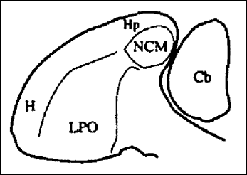
Black-capped Chickadee, Parus atricapillus

Black-capped Chickadee, Parus atricapillus
The black-capped chickadee (Parus atricapillus) is a small grey, white, and black bird that ranges across Canada and the Northern United States. It roosts in evergreen forests, eating insects and seeds. Like a number of other species (jays, nutcrackers, and tits), the black-capped chickadee stores food for later use.
Tree of Life: Passeriformes (family Paridae)
Black-capped chickadees forage for food and instead of eating it all, they store, or cache some of it for later consumption. Food caching occurs mostly during the fall and winter when food supplies are likely to become scarce. It is estimated that chickadees cache as many as one hundred thousand food items per year, usually individually, across a widespread territory and they do not reuse cache sites. They demonstrate a remarkable memory for the location of cached food items for periods ranging from hours to weeks. It has been shown in numerous laboratory and field experiments that chickadees use remembered visuo-spatial cues (rather than olfactory or other sensory cues) to recall the locations of food caches. Furthermore, certain kinds of cues are more important than others. For example, proximal cues such as the configuration of pine needles, branches, or other items immediately surrounding the cache site are not as important to successful cache recovery as more distal cues such as the arrangement of trees and other items in the vicinity of the cache site. Removal of proximal cues does not reduce the probability of food recovery nearly as much as removal of more distal cues. In an elegant experiment, Brodbeck (1994, see Selected References) showed that chickadees search for remembered food locations first in places suggested by global landmarks like the location within an aviary, second in locations suggested by a more local configuration of cues like a set of feeders, and last in locations suggested by the proximal features immediately surrounding the food cache. Thus it appears that chickadees use a complex hierarchical system of memories for visuo-spatial cues to recover cached food items.

The avian brain. Hp-hippocampus
Several lines of evidence suggest that the avian hippocampus is critical to memory for cache location. Comparative studies have shown that the hippocampus is larger in species that cache food than in close relatives that do not. Lesions of the hippocampus impair cache recovery such that chickadees with hippocampal lesions continue to cache food and search for cache locations, but they are no longer able to find them. This is consistent with well established findings from mammalian studies of the role of the hippocampus in spatial memory. Developmentally, food caching experience affects the growth of the hippocampus. When marsh tits (Parus palustris) are prevented from caching food during early development, their hippocampus does not grow as quickly as it does in birds allowed to cache food. Finally, Barnea and Nottebohm (1994, see Selected References) found that the addition of new cells to the hippocampus and the overall size of the hippocampus fluctuates seasonally, with a peak in the fall corresponding to the season when food caching behavior occurs.
Early classics:
Krushinskaya, N. (1966). Some Complex
Forms of Feeding Behavior of Nutcracker Nucifraga caryocatactes,
After Removal of Old Cortex. Z. Evoluz. Biochem. Fisiol. II, 563-568.
Tomback, D. (1980). How Nutcrackers Find Their Seed Stores. Condor 82, 10-19.
Vander Wall, S. and Balda, R. (1981). Ecology and Evolution of Food-Storage Behavior in Conifer-Seed-Caching Corvids. Z. Tierpsychol. 56, 217-242.
Reviews:
Sherry, D. (1996). Behavioural and Neural Bases of Orientation in Food-Storing
Birds. J. of Exp. Biol. 199, 165-171.
Sherry, D. (1992). Memory, the Hippocampus and Natural Selection: Studies of Food-Storing Birds. In Neuropsychology of Memory, 2nd edition (ed. L. Squire and N. Butters), pp. 521-532. New York: Guilford Press.
Some Recent Advances:
Barnea, A. and Nottebohm, F. (1994) Seasonal Recruitment of Hippocampal
Neurons in Adult Free-Ranging Black-Capped Chickadees. Proc. Natl. Acad.
Sci. U.S.A. 91, 11217-11221.
Brodbeck, D. (1994). Memory for Spatial and Local Cues: A Comparison of a Food-Storing and Nonstoring Species. Anim. Learning Behav. 22, 119-133.
Clayton, N. and Krebs, J. (1994). Hippocampal Growth and Attrition in Birds Affected by Experience. Proc. Natl. Acad. Sci. U.S.A. 91, 7410-7414.
Hampton, R., Sherry, D., Shettleworth, S., Khurgel, M., and Ivy, G. (1995). Hippocampal Volume and Food-Storing Behavior Are Related in Parids. Brain Behav. Evol. 45, 54-61.
